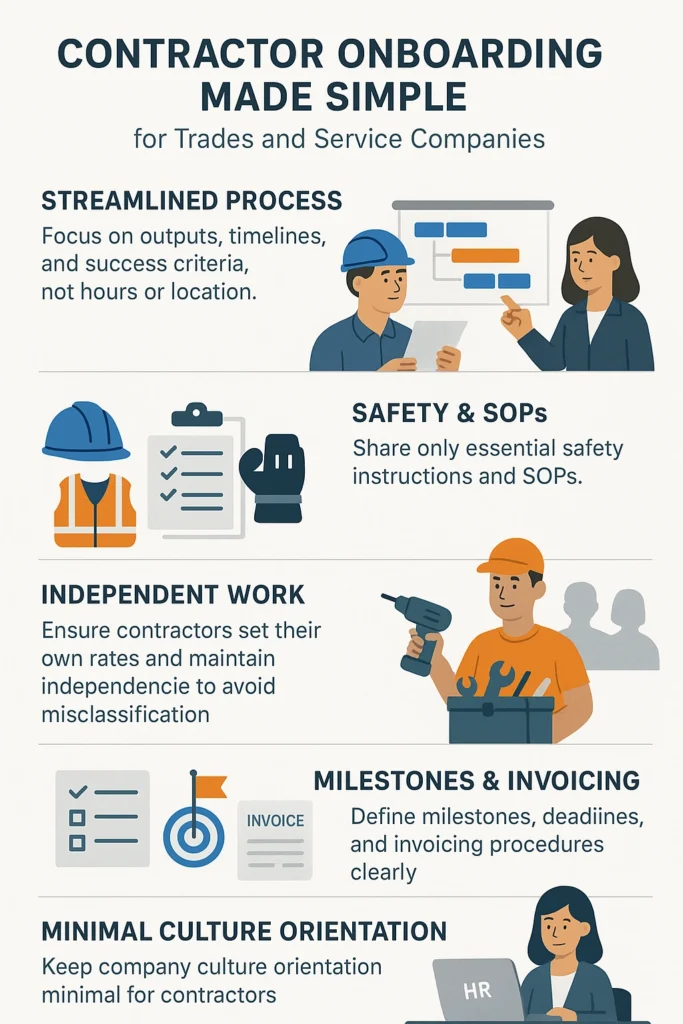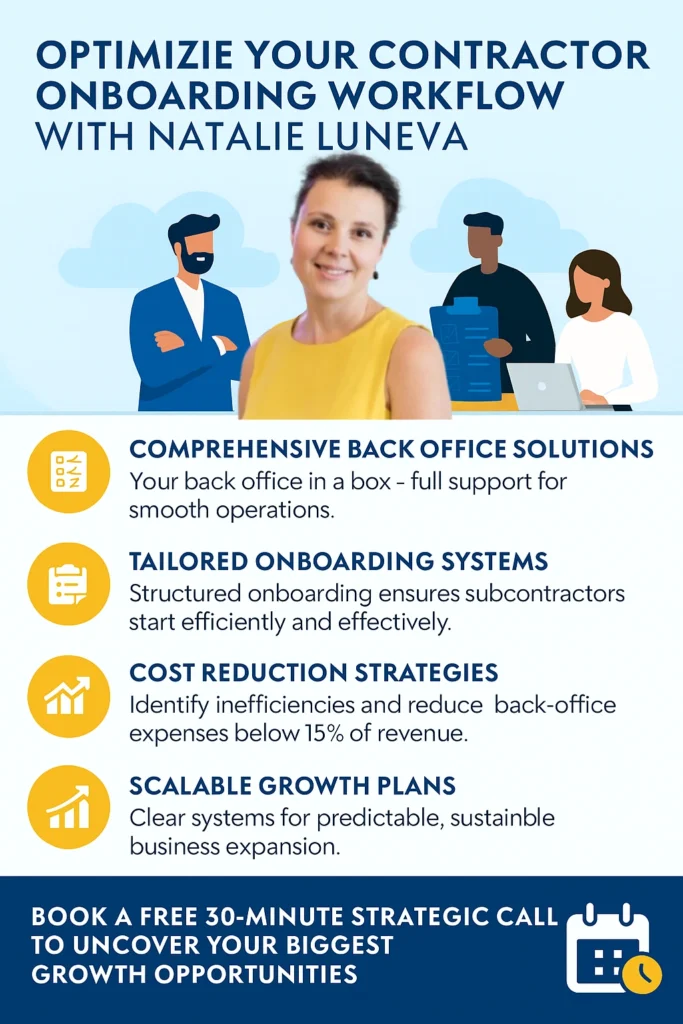A contractor onboarding workflow is a structured, repeatable process that guides new subcontractors through everything they need to start work efficiently, compliantly, and confidently. It maps out every step, from submitting required documents and verifying licenses to completing safety training, setting up access to company systems, and understanding project expectations.
For contracting businesses, a well-designed onboarding workflow turns a potentially chaotic process into a smooth, predictable system that benefits both the company and the subcontractor. In this guide, we’ll explore how to create an effective contractor onboarding workflow, including key steps, best practices, and tools that make the process faster, clearer, and more reliable.
Key Takeaways
- Build a reusable checklist covering legal forms, payments, safety, and SOPs.
- Grant access in advance with least-privilege controls and password managers.
- Automate invoicing and payments to support scaling and cross-border work.
- Run six-month classification audits to reduce misclassification risk.
- Document roles and use async communication to keep teams aligned.
What Contractor Onboarding Means for Trades and Service Companies
Bringing in skilled subs and technicians requires a streamlined approach that protects your business and schedule. Your goal is to get people to work safely and fast while avoiding employment risks.
Implementing a structured onboarding system can significantly reduce turnover, with some companies reporting a 69% decrease in turnover among construction workers when they have a well-organized onboarding process.
How onboarding contractors differs from employee onboarding
Employee orientation builds company culture, benefits, and gradual integration. For field hires, you keep that light. Focus on scope, deliverables, and clear acceptance criteria so the project starts without lengthy orientation.
Tell them what success looks like, when milestones are due, and how to submit invoices. Avoid daily supervision or internal email access to reduce the chance the relationship looks like employment.
Avoiding misclassification from day one
Misclassification brings fines, back taxes, and audits. From the start, confirm the worker sets rates, uses their own tools, and can take other clients. Document these points in your onboarding process and set a six-month compliance review at kickoff.
- Define outputs and timelines, not hours or fixed location.
- Share only essential safety and SOP information; keep culture orientation minimal.
- Use plain-language guides for communication, invoicing, and SOP access.

Build a Repeatable Contractor Onboarding Workflow
Use a master checklist to make each new hire’s ramp-up fast, compliant, and consistent across projects. Start with a living master list that foremen and coordinators reuse for every trade, plumbing, electrical, HVAC, and more.
Include contact, payment, and legal details up front. Add safety steps, SOP links, and a short ramp-up timeline so no one guesses what to do first.
Map roles clearly: who collects tax forms, who provisions access, and who verifies safety training. Set gates: access ready 48 hours before start, safety verified 24 hours prior.
- Localize checklists: include a U.S. sub-check for 1099-NEC and country-specific items for international hires.
- Standardize templates for SOWs, acceptance criteria, and job hazard analyses to speed approvals.
- Use simple software or a shared system to track completion, send alerts, and log timestamps.
End each onboarding process with a quick go/no-go verification: signed agreements, forms filed, access confirmed, and safety clearances complete. Review and update the checklist quarterly based on field feedback.
Legal, Compliance, and Documentation You Must Collect Before Work Starts
Locking down agreements and tax paperwork before day one prevents costly disputes and audits. Treat legal and tax items as a pre-start gate: no field work until each item is signed and stored.
Require a signed independent contractor agreement that covers scope, timelines, rates, IP ownership, confidentiality, liability, and termination. Attach an NDA where pricing, customer lists, or designs are sensitive. Localize clauses for state law and any international hires.
- Collect correct tax forms up front: W-9 for U.S.-based workers and W-8BEN for non-U.S. workers. Prepare to issue 1099-NEC when applicable.
- Centralize documentation in a secure repository with naming rules and restricted access to protect drawings and SOPs.
- Validate classification: worker sets schedule, sets rates, supplies tools, and can take other clients; avoid salary-like payments or daily shift control.
- Calendar a six-month compliance review to reassess role realities and changes in law.
Make the pre-start compliance check non-negotiable. Clear documentation, the right forms, and routine reviews keep your business compliant and payments moving smoothly.
Training, Safety Checks, and SOP Orientation for On-Site and Field Work
A compact training plan speeds readiness and keeps sites safe without heavy meetings. You should verify safety credentials and give people clear, role-specific materials before the first visit. Use a kickoff to define the primary channel for job updates (for example, Slack for quick notes, email for records) and grant access to guides in advance.
Safety training and verification for technicians and subs
Confirm OSHA certificates, required PPE, trade licenses, and any site-specific orientations before arrival. Require short acknowledgments in your tracker for critical modules like lockout/tagout and ladder safety.
Distributing SOPs, style guides, and example deliverables
Share concise SOPs for pre-arrival checks, on-site steps, cleanup, and customer sign-off. Include sample deliverables, a filled service report, a punch list, and an as-built photo set, so your team knows what “done” looks like.
Using async documentation to shorten ramp-up time
Deliver handbooks, short videos, and quick-reference sheets through an async portal so people self-serve on their schedule. Assign a low-risk project first to validate training and capture field feedback to refine processes.
- Keep modules short and role-specific to avoid overload.
- Record acknowledgments and reconfirm access at the pre-start gate.
| Item | What to collect | When to verify |
| Safety credentials | OSHA cards, licenses, PPE confirmation | Before first site visit |
| SOPs & examples | Checklists, sample reports, photo sets | Shared at kickoff; acknowledged in tracker |
| Training media | Short videos, guides, quizzes | Completed and logged before higher-risk projects |
Provision Access and Tools Without Exposing Your Systems
Give external teams just the access they need so your systems stay secure as projects scale. Plan access by role, confirm accounts before day one, and keep removal dates visible so permissions don’t linger.
Grant least-privilege access to software, comms, and files
Map required systems by role: communications, file storage, project boards, and field apps. Grant only the rights needed to complete deliverables and restrict sensitive client or payment folders.
Create time-bound accounts for short jobs and set calendar reminders for removals. Standardize folder names and file locations so contractors find information fast without extra messages.
Use password managers and access tracking to stay secure
Use a password manager (for example, LastPass or Dashlane) to share credentials securely and differentiate HR/ops access from external access. Enable MFA and test logins before the first shift.
- Keep a central access log noting approver, permissions, and expiry to make audits quick.
- Run a pre-start checklist: invite sent, login tested, MFA enabled, test upload or message posted.
- Train your team on least-privilege benefits to avoid accidental over-sharing.
- For shared devices, enforce passcodes and remote wipe to protect company data.
| Item | Action | Who approves | Expiry / Review |
| Communications app | Grant channel access, read/write as needed | Ops lead | End date + six-month review |
| File storage | Provide role-based read/write; restrict finance folders | IT manager | Remove after project or at review |
| Field apps | Provision limited features; test data sync | Project manager | Time-bound account, auto-expire |
| Shared device | Enroll in MDM, enable passcode and remote wipe | IT team | Return or wipe at contract end |
Communication Norms, Scheduling, and Measurement
Clear communication rules stop small issues from turning into costly delays on any job site. Set basic expectations up front so your teams and outside trades know how to share progress and surface problems.
Set points of contact, feedback workflows, and async expectations
Name a single point of contact for each contractor and record the preferred channel and expected response time. Use async updates, short written notes or 60–90 second recordings, so people on different schedules can stay current.
Define a feedback loop: who reviews work, how many revision rounds are allowed, and a clear submission method to avoid rework.
Define scope, milestones, and success metrics in writing
Attach scope, acceptance criteria, and milestone dates to the onboarding packet. Tie invoicing checkpoints to those milestones so payments follow measurable progress, not hours.
- Keep systems lightweight: a shared board or simple tracker is usually enough.
- Ask contractors to report risks in writing early so you can remove blockers.
- Summarize live calls in a short note and store it where the team can find it.
| Report | Channel | Owner |
| Daily status (short) | Project board note | Assigned point of contact |
| Milestone delivery | Shared folder + summary | Project lead |
| Risk / blocker | Email or message with tag | Site supervisor |
Automate Payments and Streamline Contractor Management Software
Managing payments for multiple subcontractors can quickly become overwhelming, especially when schedules, methods, and compliance requirements vary. Manual processes often lead to errors, delays, and strained relationships. DepositFix offers a powerful solution to automate and streamline billing and payment management, helping contracting businesses save time, reduce mistakes, and improve cash flow.
Key benefits of using DepositFix for contractor management include:
- Automated Billing and Invoicing: Send invoices and accept payments effortlessly, reducing manual work and ensuring timely payments.
- Recurring Billing: Set up recurring invoices for ongoing maintenance, service contracts, or repeat clients, minimizing administrative overhead.
- Progress Payments: Collect payments at different project milestones, improving cash flow and reducing financial risk.
- Accounting Integrations: Seamlessly connect with accounting software to automate expense reporting, reconciliation, and project profitability analysis.
- Mobile Access: Manage billing and payments directly from the job site, keeping your financial operations flexible and efficient.
With DepositFix’s tools, contracting businesses can automate payments, simplify contractor management, and maintain strong relationships with subcontractors while staying compliant and financially organized.
Optimize Your Contractor Onboarding Workflow with Natalie Luneva
Natalie Luneva specializes in transforming chaotic back-office operations into well-oiled systems that support sustainable growth. With over a decade of experience in marketing and operations, she has successfully guided trades businesses, including roofing, HVAC, plumbing, and electrical companies, to optimize their workflows and reduce administrative overhead.
When you partner with Natalie, you can expect:
- Comprehensive Back Office Solutions: Access to a team of experts covering finance, marketing, operations, and administration, effectively becoming your back office in a box.
- Tailored Onboarding Systems: Implementation of structured onboarding processes that include training checklists and progress reviews, ensuring new subcontractors are integrated efficiently and effectively.
- Cost Reduction Strategies: Identification and elimination of inefficiencies, potentially reducing back office expenses to below 15% of revenue.
- Scalable Growth Plans: Development of clear processes and systems that facilitate predictable and sustainable business expansion.

To learn more about how Natalie can help optimize your contractor onboarding workflow, book a free 30-minute call to uncover your biggest growth opportunities.
Conclusion
A well-designed contractor onboarding workflow is the backbone of efficient, compliant, and productive subcontractor management. With standardized processes, from legal documentation and safety training to access provisioning and milestone tracking, contracting businesses reduce errors, minimize compliance risks, and set subcontractors up for success from day one.
Automating payments with tools like DepositFix and optimizing workflows with experts such as Natalie Luneva further streamlines operations, improves cash flow, and frees your team to focus on project execution. Investing in a repeatable, structured onboarding process not only protects your business but also builds strong, professional relationships with subcontractors, ensuring projects run smoothly and predictably.
FAQs
What is the average time it takes to onboard a subcontractor?
The onboarding timeline varies by trade and complexity of the project, but most subcontractors can be fully onboarded in 3–7 business days when using a structured workflow. Automation and pre-collected documentation can reduce this significantly.
Can subcontractor onboarding be done remotely?
Yes, much of the onboarding process, document submission, training modules, SOP reviews, and even milestone tracking, can be completed remotely using digital platforms and cloud-based tools. On-site verification is only needed for safety checks or access provisioning.
How do I track subcontractor compliance over time?
Use a combination of digital checklists, automated reminders, and periodic audits (e.g., six-month classification reviews). This ensures subcontractors remain compliant with safety, tax, and legal requirements throughout their engagement.
How can I measure the effectiveness of my onboarding workflow?
Track key metrics such as the average time to first productive work, the number of compliance errors, subcontractor satisfaction ratings, and on-time milestone completion. These indicators highlight bottlenecks and areas for improvement.
What information should I collect from subcontractors before their first day?
Collect legal documents (contracts, NDAs, W-9/W-8 forms), proof of licenses and certifications, insurance information, and emergency contact details. Optional but helpful items include references, previous project portfolios, and equipment lists.
Can onboarding workflows be customized for different trades?
Absolutely. A flexible workflow should account for trade-specific requirements, such as safety certifications for electricians, licensing for HVAC technicians, or unique insurance needs for plumbing contractors.


